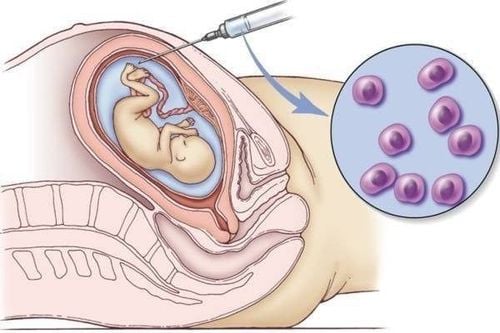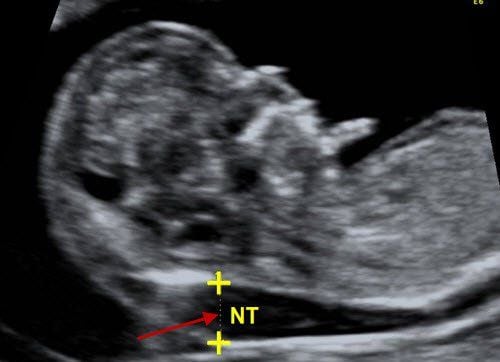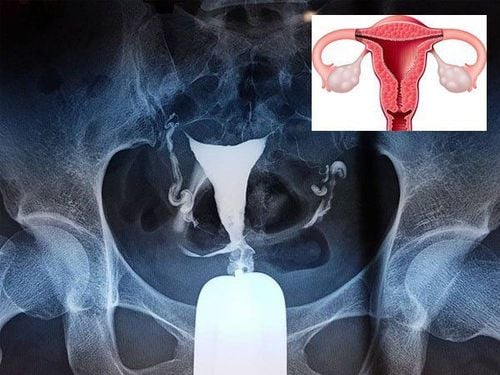This is an automatically translated article.
The article is professionally consulted by an Obstetrician and Gynecologist - Department of Obstetrics and Gynecology - Vinmec Phu Quoc International General Hospital
The normal fetal umbilical cord contains two umbilical arteries and one umbilical vein within the Wharton agar. Single artery umbilical cord is one of the common umbilical cord abnormalities, potentially endangering the health of the fetus if not detected early.
1. How is the umbilical cord an artery?
A normal umbilical cord consists of two umbilical arteries and an umbilical vein with a layer of Wharton jelly covering the outside that nourishes and protects the blood vessels. The umbilical vein is responsible for transporting oxygen-rich blood from the mother through the placenta to the fetus, while the umbilical artery transports oxygen-poor blood from the fetus to the placenta for metabolism. The umbilical vein is larger in diameter than the umbilical artery and lies deeper.
Single artery umbilical cord occurs in about 1% of pregnancies, when the umbilical cord consists of only two blood vessels. The incidence of single-arterial umbilical cord involvement was higher in multiple pregnancies than in singleton pregnancies. Single-arterial umbilical cord anomalies may occur alone or in association with abnormalities in other organs such as the cardiovascular, nervous, urinary, and skeletal systems, or be suggestive of abnormalities. chromosome . If it exists alone, the single-arterial umbilical cord has a good prognosis, and the health and development of the fetus is considered normal. Thanks to the development of imaging tools such as ultrasound, a single-arterial umbilical cord can be detected before birth, along with other birth defects if present. Single-arterial umbilical cords are best determined by examination after the baby is born.

Thông thường một dây rốn có hai động mạch rốn
2. Cause of single artery umbilical cord
The cause of single-arterial umbilical cord abnormalities is not well understood. Many authors agree with the following hypotheses explaining the occurrence of a single-arterial umbilical cord:Failure to develop an umbilical artery early in pregnancy. Regression of one of the two umbilical arteries during the development of pregnancy. That is, right from the time of formation, the umbilical cord consists of 3 normal blood vessels, but one umbilical artery will disappear later. A single artery umbilical cord can be a solitary abnormality or be the manifestation of other chromosomal abnormalities such as Down syndrome and Edwards syndrome. Risk factors for a pregnancy with a single artery umbilical cord include:
Maternal pregnancy older than 40 years History of previous multiple births Multiple pregnancy Gender of the fetus being female Pregnant smoking The mother has medical conditions such as diabetes, high blood pressure. Complete single-arterial umbilical cord anomaly may be present in pregnancies without the above risk factors. Therefore, in order to have a healthy pregnancy, pregnant women need to have regular antenatal check-ups on time and should not skip the ultrasound screening for fetal malformations.

Phụ nữ mang đa thai làm tăng nguy cơ dây rốn một động mạch
3. Diagnosis of single artery umbilical cord
Today, ultrasonography is the primary means of diagnosing a single-arterial umbilical cord and detecting associated abnormalities. This is a non-invasive and safe imaging tool for both mother and fetus that can be easily repeated many times. About a quarter of cases of single artery umbilical cords can lead to complications such as threatened preterm birth, premature birth, and intrauterine growth retardation. In rare cases, a single-arterial umbilical cord is associated with abnormalities of other body systems such as the nervous, cardiovascular, urinary, and skeletal systems. Prenatal ultrasound is helpful in detecting these accompanying abnormalities, thereby guiding the decision to perform further interventions on pregnancy such as amniocentesis. The fetal development is also well monitored through consecutive fetal ultrasounds, early detection of growth retardation for timely treatment plans.Besides, a number of other testing methods can also be applied in the diagnosis and management of single-arterial umbilical cord abnormalities such as noninvasive prenatal diagnostic tests, amniocentesis, chorionic villus biopsies. . The appointment of these in-depth tests is guided by previous fetal ultrasound.

Sinh thiết gai nhau giúp chẩn đoán dây rốn một động mạch
4. Principles of labor management in pregnancies with single artery umbilical cord
A single artery umbilical cord is an abnormality with a good prognosis if it is present alone and is not accompanied by other congenital anomalies. Pregnant women who are found to have a single artery umbilical cord should be properly counseled on prognosis and appropriate management. When entering labor, some principles should be followed well in pregnancies with a single artery umbilical cord:Single artery umbilical cord is not an indication for cesarean section. A vaginal birth can be followed like a normal pregnancy. The fetal heart rate should be closely monitored. Cardiovascular and urinary tract studies should be repeated after birth. Practice breastfeeding. Single artery umbilical cord is one of the common umbilical cord abnormalities, potentially endangering the health of the fetus if not detected early. Therefore, pregnant women during pregnancy need periodic antenatal check-ups and should not skip the screening stages for fetal malformations.

Bệnh viện Đa khoa Quốc tế Vinmec đã và đang tiếp tục triển khai dịch vụ thai sản trọn gói
Currently, to improve service quality, Vinmec is also equipped with a system of ultrasound machines and modern medical equipment. Accordingly, the examination and diagnosis process at Vinmec is carried out by qualified and well-trained doctors, so it will soon detect obstetric problems and pathologies, fetal malformations from early (if any) for timely examination and treatment right after the baby is born.
Please dial HOTLINE for more information or register for an appointment HERE. Download MyVinmec app to make appointments faster and to manage your bookings easily.













